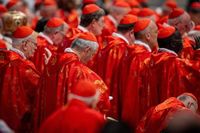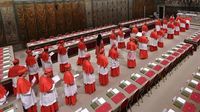The Vatican is currently in a state of anticipation as it awaits the white smoke signaling the election of a new pope, following the first vote at the conclave which did not yield a decision. Black smoke billowed from the chimney of the Sistine Chapel on the evening of May 7, 2025, indicating that no pope had been elected, much to the disappointment of the thousands gathered in St. Peter's Square.
The conclave, which began with 133 electors, including four Polish cardinals—Stanisław Ryłko, Kazimierz Nycz, Konrad Krajewski, and Grzegorz Ryś—has highlighted the existing divisions among the cardinals. Italian newspapers have noted that the candidates considered favorites are still far from obtaining the necessary support to secure the papacy. According to La Repubblica, there is a significant gap between the leading candidates and the two-thirds majority required for election.
Cardinal Pietro Parolin, who has been a prominent figure in the Vatican, presided over the first day of voting. The first vote was described by La Stampa as a "referendum" on his candidacy. Despite being a strong contender, reports suggest that Parolin may currently command about 50 votes, needing at least 89 to win. If the voting extends to Friday, May 9, 2025, other candidates may be considered, particularly those who could bridge the gap between the progressive and conservative factions within the Church.
As the electors prepare for a second round of voting scheduled for Thursday, May 8, 2025, the Italian press has focused on the unity among French cardinals, who are rallying behind Marseille's Metropolitan Jean-Marc Aveline. This solidarity among the French cardinals has been described as a "lesson" for others within the conclave.
Massimo Franco from Corriere della Sera has noted that the atmosphere surrounding this conclave is one of confrontation, with sharply differing views on the future direction of the Church. Supporters of Pope Francis, particularly from Latin America, are hoping for a continuation of his legacy, with some even calling for the election of a "Francis II." Franco points out that in the past, the selection of a papal successor has not featured a candidate with Parolin's profile, who has served loyally in various capacities under Pope Francis.
On the other hand, Il Messaggero emphasizes the uncertainty surrounding the conclave, suggesting that expectations for a swift election may have been overly optimistic. The tradition of waiting for the results of the voting has become a significant event, drawing attention from both believers and non-believers alike, and has evolved into a global spectacle, especially in the age of social media.
As the electors gather once again to cast their votes, the world watches closely, hoping for a resolution to the leadership crisis within the Catholic Church. The outcome of this conclave is not just a matter of ecclesiastical importance; it also carries significant implications for the Church's stance on various contemporary issues, reflecting the diverse and sometimes conflicting perspectives within its ranks.
In summary, the initial day of voting at the Vatican conclave has left many questions unanswered, with no clear frontrunner emerging. As the cardinals prepare for another round of voting, the stakes are high, and the future direction of the Catholic Church hangs in the balance.


